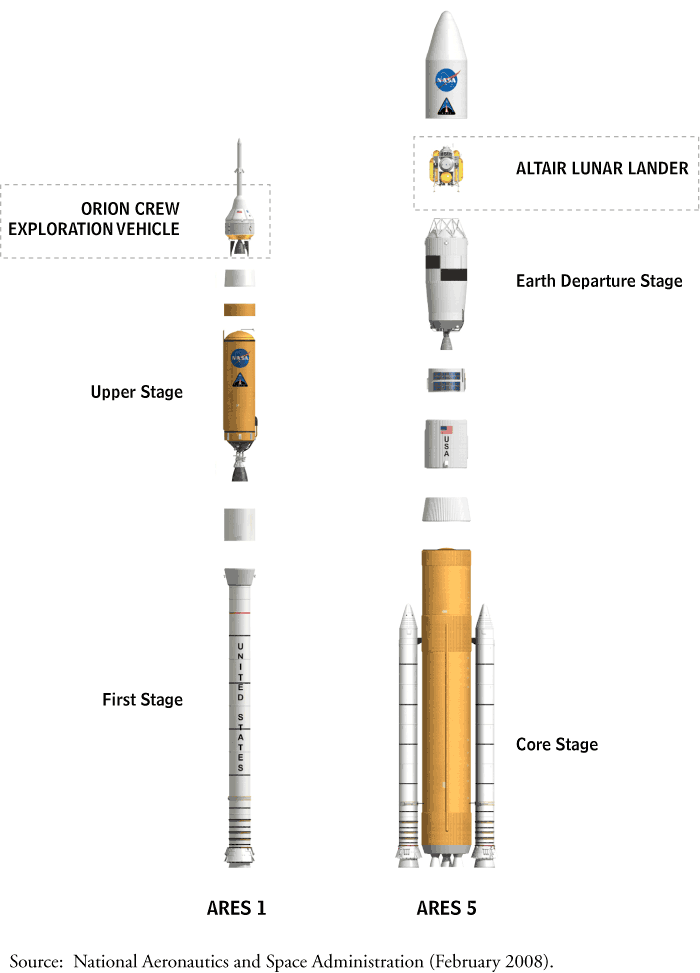The Budgetary Implications of NASA’s Current Plans for Space Exploration
April 2009
Notes
Numbers in the text and tables may not add up to totals because of rounding.
Unless otherwise noted, dollar amounts in this report are 2009 dollars of budget authority.
 |
Preface
In response to a directive in the National Aeronautics and Space Administration Authorization Act of 2008, the Congressional Budget Office (CBO) has updated its 2004 report analyzing the budgetary implications of the National Aeronautics and Space Administration’s (NASA’s) vision for the nation’s space exploration program. On the basis of NASA’s current estimates of costs, this report considers the effects that cost growth could have on the Constellation program, which will produce the agency’s new generation of spacecraft designed for human spaceflight, and updates comparisons of the costs for that program with those for the Apollo program and past proposals for human exploration of the moon.
Kevin Eveker of CBO’s National Security Division prepared the report under the supervision of J. Michael Gilmore. Leigh Angres of the Budget Analysis Division assisted with preparation of the cost estimates under the supervision of Kim Cawley. Alec Johnson assisted with fact checking the document. David Arthur, Christine Bogusz, and Paul Cullinan reviewed earlier drafts of the report.
John Skeen edited the manuscript, and Sherry Snyder proofread it. Cynthia Cleveland assisted in producing drafts. Maureen Costantino prepared the report for publication. Lenny Skutnik produced the printed copies, Linda Schimmel coordinated the print distribution, and Simone Thomas prepared the electronic version for CBO’s Web site.
April 2009
Contents
Expected Cost Growth in NASA’s Programs and Alternative Scenarios
Comparison of the Constellation and Apollo Programs
Appendix: Details of NASA’s Plans, by Directorate and Function
1. Budgets and Schedules for NASA’s Plans and Alternative Scenarios
2. Projected Average Annual Funding for NASA’s Plans
3. Projected Average Annual Funding for NASA Under Alternative Scenarios
A-1. Projected Average Annual Funding for the Exploration Systems and the Space Operations Mission Directorates
A-2. Projected Average Annual Funding for the Science and the Aeronautics Research Mission Directorates
A-3. Projected Average Annual Funding for NASA’s Cross-Agency Support
1. Projected Funding for NASA’s Plans
2. Projected Schedules for NASA’s Plans
3. Effects on NASA’s Plans Under Scenario 1: Keep Funding Fixed and Allow Schedules to Slip
4. Projected Funding Under Scenario 2: Execute NASA’s Current Plans and Extend Operation of the Shuttle and Space Station
5. Effects of Scenario 2: Execute NASA’s Current Plans and Extend Operation of the Shuttle and Space Station
6. Effects of Scenario 3: Achieve the Constellation Progam’s Schedule and Allow the Science Schedule to Slip
7. Projected Funding Under Scenario 4: Absorb Cost Growth to Achieve Constellation’s Schedule by Reducing Funding for Science and Aeronautics
8. Effects of Scenario 4: Absorb Cost Growth to Achieve Constellation’s Schedule by Reducing Funding for Science and Aeronautics
9. Comparison of the Constellation, Apollo, and Other Programs
A-1. Planned Budgets for the Exploration Systems and the Space Operations Mission Directorates
A-2. Planned Budgets for the Science and the Aeronautics Research Mission Directorates
